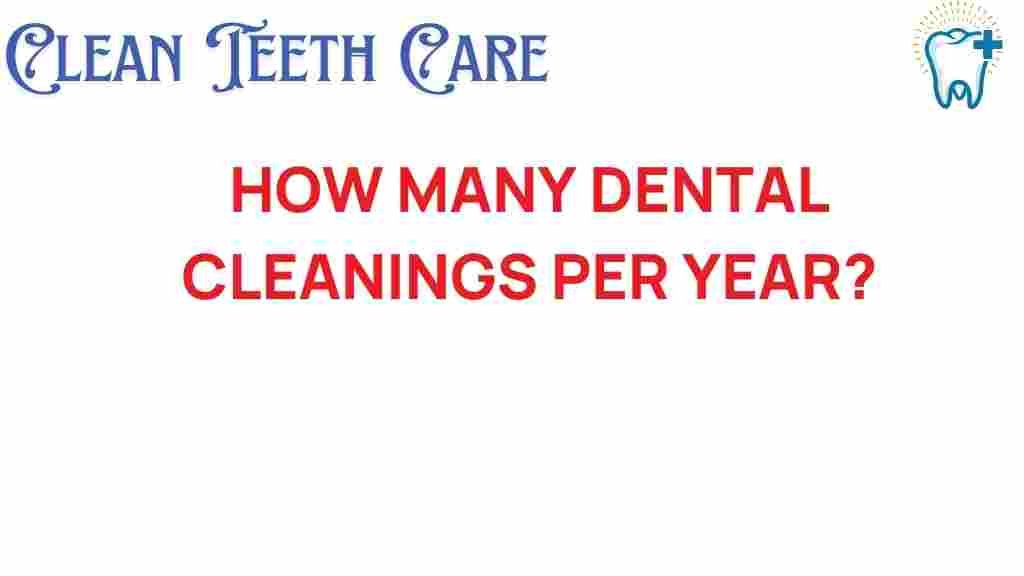The Surprising Truth: How Many Dental Cleanings Do You Really Need?
Maintaining good oral health is essential for everyone, but how often should you really get dental cleanings? The answer might surprise you. Many people believe that regular dentist visits for teeth cleaning are just a routine necessity. However, understanding the importance of preventive care and how it affects your dental hygiene can help you make better decisions for your oral health.
Understanding Dental Cleanings
Dental cleanings are professional procedures performed by dental hygienists or dentists to remove plaque, tartar, and stains from your teeth. The goal of these cleanings is to prevent gum disease, cavities, and other oral health issues.
During a typical cleaning, you can expect:
- A thorough examination of your mouth
- Scaling to remove plaque and tartar
- Polishing your teeth to remove stains
- Fluoride treatment to strengthen teeth
While most people know they should get cleanings, the frequency of these appointments can vary based on individual needs. So, how do you determine the right schedule for your routine check-ups?
Factors Influencing the Need for Dental Cleanings
Your need for dental cleanings depends on several factors, including:
1. Personal Oral Health
Your current oral health status plays a significant role in how often you should visit the dentist. If you have a history of gum disease or cavities, you may require more frequent cleanings.
2. Age
As you age, your risk for dental problems often increases. Older adults may need more frequent visits to maintain their oral health.
3. Lifestyle Habits
Certain habits can impact your dental health. For instance, if you smoke or consume high amounts of sugar, you may need more frequent cleanings to combat the effects on your teeth and gums.
4. Medical Conditions
Some medical conditions, like diabetes or heart disease, can affect your dental hygiene needs. If you have a chronic illness, consult with your dentist to determine the best cleaning schedule for you.
5. Dental Hygiene Practices
Your daily oral care routine significantly impacts your dental health. Regular brushing and flossing can reduce the need for frequent teeth cleaning.
Recommended Frequency of Dental Cleanings
The American Dental Association (ADA) recommends that individuals visit the dentist for a check-up and cleaning at least twice a year. However, some people may require more frequent visits. Here’s a breakdown:
- Every 6 months: Ideal for most adults with good oral health.
- Every 4 months: Recommended for individuals with a history of gum disease or other dental issues.
- Every 3 months: Necessary for patients with severe periodontal disease.
These recommendations can vary based on your specific situation, so it’s essential to discuss your needs during your routine check-ups with your dentist.
What to Expect During Your Dental Cleaning Appointment
<pKnowing what happens during a dental cleaning can help alleviate any anxiety you may have about the procedure. Here’s a step-by-step process:
Step 1: Initial Assessment
Your hygienist will begin by examining your mouth, checking for signs of gum disease, cavities, or other issues. This examination helps determine the level of cleaning required.
Step 2: Scaling
Using specialized tools, the hygienist will remove plaque and tartar buildup from your teeth and along the gumline. This process is crucial in preventing gum disease.
Step 3: Polishing
After scaling, your teeth will be polished using a gritty toothpaste that helps to remove surface stains and makes your teeth feel smooth.
Step 4: Flossing
The hygienist will floss your teeth to ensure that all debris is removed from between them, where a toothbrush may not reach effectively.
Step 5: Fluoride Treatment
Finally, a fluoride treatment may be applied to help strengthen your teeth and protect against cavities.
Maintaining Oral Health Between Dental Cleanings
<pWhile regular dental cleanings are important, you can take several steps to maintain your oral health in between visits:
- Brush Twice Daily: Use fluoride toothpaste and a soft-bristled toothbrush to brush your teeth at least twice a day.
- Floss Daily: Flossing helps remove food particles and plaque between your teeth.
- Limit Sugary Foods: Reducing sugar intake can help prevent cavities and improve your overall dental hygiene.
- Stay Hydrated: Drinking water can help wash away food particles and promote saliva production, which protects your teeth.
- Quit Smoking: If you smoke, consider quitting, as it significantly increases the risk of gum disease.
Common Concerns and Troubleshooting Tips
Many patients have common concerns regarding dental cleanings. Here are some troubleshooting tips:
Concern: Fear of Pain
Tip: Communicate with your dental hygienist about your fears. They can use gentle techniques and may offer numbing options if necessary.
Concern: Time Constraints
Tip: Schedule your appointments at a time that works best for you. Many dental offices offer flexible hours.
Concern: Understanding Costs
Tip: Discuss payment options and insurance coverage with your dental office to alleviate financial concerns.
Concern: Forgetting Appointments
Tip: Set reminders on your phone or calendar to keep track of your routine check-ups.
Conclusion
Understanding how many dental cleanings you need is integral to maintaining your oral health. While the general guideline suggests visiting the dentist twice a year, individual factors may necessitate more frequent visits. Prioritize your dental hygiene by following a diligent at-home care routine and staying informed through patient education from your dental care providers.
Remember, the key to preventing gum disease and other dental issues is regular dental cleanings and proactive care. If you’re unsure of your ideal cleaning schedule, consult with your dentist to tailor a plan that suits your needs.
For more information on maintaining your dental health, check out this comprehensive guide on dental hygiene. And, if you’re looking for tips on how to choose a dentist, visit this resource.
This article is in the category Prevention and created by CleanTeethCare Team
